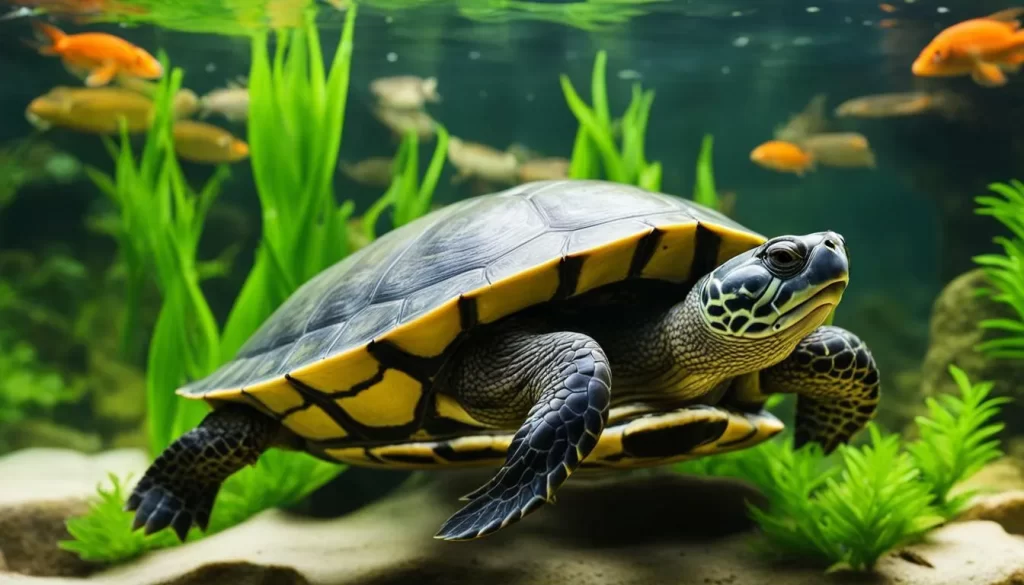The amount of water you should put in a turtle tank depends on the species of turtle and their specific water requirements.
Determining the optimal water quantity is crucial for creating a healthy and suitable habitat for your pet.
Key Takeaways:
- Aquatic turtles should have at least 60% of the tank filled with water.
- Tortoises require very little water in their tank and a primarily terrestrial environment.
- Semi-aquatic turtles need a mixture of water and land, with at least 25% of the tank filled with water.
- Regular water changes of around 25% every two weeks are essential for maintaining water quality.
- Ensure the tank size is appropriate, with a general guideline of 10 to 15 gallons of water per one inch of turtle.
- Tap water should be tested or treated to meet proper pH, chlorine, ammonia, nitrite, and nitrate levels.
By understanding the specific water requirements of your turtle, you can provide it with a habitat that promotes its overall health and happiness.
Water Requirements for Aquatic Turtles
Aquatic turtles, such as Red-eared Sliders, require a significant amount of water in their tank, with at least 60% of the tank filled to create an optimal habitat.
The depth and capacity of the water play a crucial role in providing the right environment for these turtles to thrive.
To ensure the well-being of your aquatic turtle, it is recommended to maintain a water depth that allows them to fully submerge themselves and swim freely.
Providing a minimum depth of 6 to 8 inches will enable them to engage in natural behaviors and exercise their limbs.
Additionally, the water should be clean and free from any contaminants to prevent the risk of infections or diseases.
Creating a semi-aquatic environment is also essential for aquatic turtles. This means incorporating basking spots and platforms where they can rest and receive UVB light.
These areas should be positioned above the waterline, allowing the turtles to regulate their body temperature and dry off completely after swimming.
By ensuring the proper water depth and offering a semi-aquatic setup, you are providing your aquatic turtle with an enriching habitat that mimics their natural environment.
Remember to regularly monitor the water quality and temperature, as well as perform routine water changes to maintain the health and well-being of your beloved pet turtle.
Water Needs for Tortoises
Unlike aquatic turtles, tortoises have minimal water requirements and should have a primarily terrestrial habitat with only a small water source available.
These reptiles are adapted to desert and arid environments, where they obtain most of their hydration from the food they eat.
However, it is still important to provide a shallow water dish for them to soak in and drink from, as this helps with their digestion and overall health.
The water dish should be shallow enough for the tortoise to comfortably enter and exit, but deep enough to allow them to immerse their entire body if desired.
A small ceramic or plastic dish that is easy to clean and resistant to tipping over is recommended.
Make sure to provide fresh water daily, as tortoises can be messy drinkers and may soil the water quickly.
It’s also crucial to maintain proper humidity levels in the tortoise enclosure. Most species require a humidity level of around 40-60%.
This can be achieved by misting the enclosure with water and providing a humidity hide or moist substrate to create a microclimate within the enclosure.
Monitoring the humidity levels using a hygrometer is recommended to ensure the tortoise’s well-being.
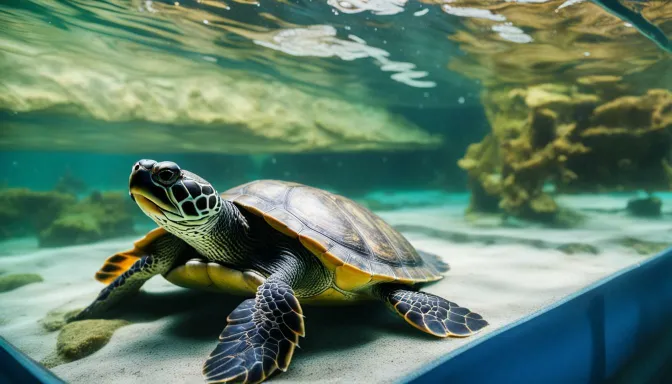
Some species of tortoises, such as the red-footed tortoise and the yellow-footed tortoise, have a semi-aquatic lifestyle.
These tortoises require a larger water area in their enclosure compared to purely terrestrial species.
The water area should be at least 25% of the total tank size, allowing them to fully submerge and swim around.
In addition to the water area, it’s important to provide suitable basking spots for semi-aquatic tortoises.
These can be created using rocks or platforms placed above the water, allowing the tortoise to climb out and dry off after swimming.
The basking area should have a temperature gradient, with one side being warmer for basking and the other side cooler for the tortoise to regulate its body temperature.
By understanding and meeting the water needs of tortoises, you can create a suitable habitat that promotes their health and well-being.
Providing a small water source for hydration, maintaining proper humidity levels, and accommodating the needs of semi-aquatic species will help ensure that your tortoise thrives in its environment.
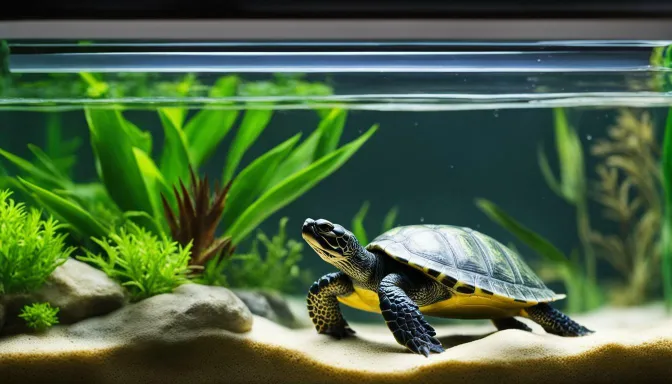
Semi-Aquatic Turtle Tank Setup
Semi-aquatic turtles, such as Box Turtles, require a balanced setup with a mixture of water and land, with approximately 25% of the tank filled with water.
This allows them to enjoy both aquatic and terrestrial environments, which are essential for their overall well-being.
Creating the right habitat for your semi-aquatic turtle requires careful consideration of water depth, land area, and other important factors.
To create the ideal setup, start by ensuring that the water depth is appropriate for your turtle. For most semi-aquatic turtles, a water depth of around 2-4 inches is sufficient.
This allows them to swim comfortably without being overwhelmed by too much water. Incorporate a gentle sloping ramp or a pile of rocks for your turtle to easily access the land area from the water.
When it comes to the land area, provide a variety of substrate materials and hiding spots to mimic their natural habitat.
You can use a combination of soil, moss, and rocks to create a suitable environment for your turtle to explore and burrow.
Adding live plants can also provide shade, shelter, and a source of food for your pet.
Remember to regularly maintain the tank’s temperature and humidity levels, as well as provide proper lighting and a source of heat for basking.
Monitoring these factors ensures the optimal conditions for your semi-aquatic turtle’s health and happiness.
By providing a well-balanced setup with a mixture of water and land, you can create a stimulating and enriching habitat for your semi-aquatic turtle to thrive.
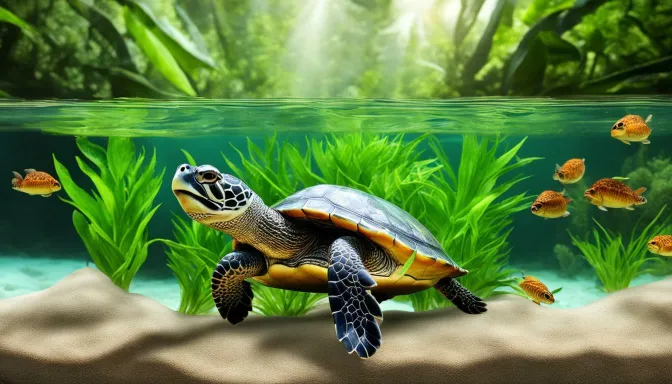
Example Table: Recommended Water and Land Dimensions for Semi-Aquatic Turtles
| Turtle Species | Minimum Water Depth | Minimum Land Area |
|---|---|---|
| Box Turtle | 2-4 inches | At least 75% of tank |
| Painted Turtle | 2-3 inches | At least 75% of tank |
| Mud Turtle | 3-5 inches | At least 75% of tank |
Tank Size and Water Volume Guidelines
It is crucial to have a turtle tank that is adequately sized to accommodate the needs of your turtle, with a general guideline of at least 10 to 15 gallons of water for every one inch of turtle.
This ensures that your turtle has enough space to swim and move around comfortably. Providing a spacious tank is essential for their overall health and well-being.
When determining the water volume for your turtle tank, it is important to consider the species of turtle you have.
Aquatic turtles, for example, require a tank filled with at least 60% water to create a suitable environment for their semi-aquatic lifestyle.
Tortoises, on the other hand, require very little water in their tank as they are mainly terrestrial creatures.
It is best to provide a shallow water dish or bowl for tortoises to drink from.
If you have a semi-aquatic turtle, it is recommended to have a tank setup that includes both water and land areas.
A suitable water-to-land ratio for semi-aquatic turtles is around 25% water and 75% land. This allows them to have access to both environments, ensuring they can swim and also have a dry area to bask and rest.
| Turtle Species | Water Volume Recommendation |
|---|---|
| Aquatic Turtles | At least 60% of the tank |
| Tortoises | Very little water, shallow dish or bowl for drinking |
| Semi-Aquatic Turtles | Around 25% of the tank |
Remember to regularly monitor and maintain the water quality in your turtle tank. Clean water is essential for your turtle’s health.
Tap water should be tested or treated to ensure it meets the appropriate pH, chlorine, ammonia, nitrite, and nitrate levels.
Testing kits are available to help you monitor these parameters and ensure your turtle’s habitat remains clean and suitable for their well-being.
By following these tank size and water volume guidelines, you can provide a comfortable and appropriate habitat for your turtle.
Remember to consider the specific needs of your turtle species and regularly maintain the water quality to ensure their overall health and happiness.
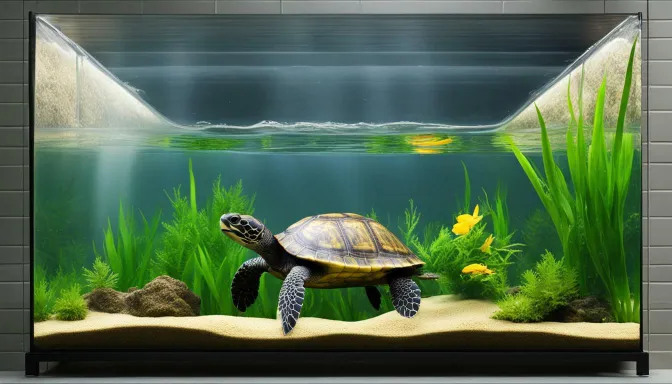
Regular water changes are crucial for maintaining a clean and healthy turtle tank, with a recommended water change of approximately 25% every two weeks.
This ensures that the water quality remains optimal for your turtle’s well-being. A stagnant and dirty environment can lead to various health issues, such as respiratory problems or shell rot.
By performing regular water changes, you remove harmful substances, such as excess waste, ammonia, and nitrates, while replenishing the tank with fresh water.
During water changes, it is important to siphon out any debris or uneaten food from the bottom of the tank, as these can contribute to water pollution.
Additionally, monitor the water parameters regularly using appropriate testing kits to ensure that the pH, chlorine, ammonia, nitrite, and nitrate levels are within the recommended range for your turtle’s species.
This helps prevent potential health issues and provides a comfortable and suitable habitat for your pet.
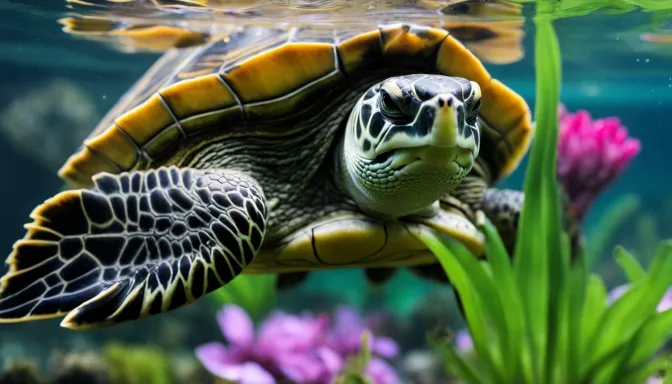
Pro Tips for Water Changes:
- Use a siphon or a gravel vacuum to remove debris from the bottom of the tank during water changes.
- Make sure to treat tap water with a dechlorinator to remove chlorine and other harmful chemicals.
- Consider investing in a good quality filtration system to help maintain water quality between water changes.
- Keep a log of your water changes and test results to track any patterns or changes in water quality over time.
By following these guidelines and regularly performing water changes, you can provide a clean and healthy habitat for your turtle, ensuring its overall well-being and happiness.
Water Quality and Testing
Ensuring proper water quality is essential for the overall health and well-being of your turtle, and it is crucial to test or treat tap water to maintain appropriate pH, chlorine, ammonia, nitrite, and nitrate levels.
These parameters play a vital role in creating a suitable habitat for your pet and preventing water-related issues.
To start, it’s important to check the pH level of your turtle tank’s water. The ideal pH range for most turtles is between 6.8 and 7.8. pH test kits are readily available and easy to use, allowing you to monitor and adjust the pH level accordingly.
In addition to pH, it’s essential to monitor chlorine levels in your turtle’s water. Chlorine, commonly found in tap water, can be harmful to turtles.
You can remove chlorine by using a water conditioner specifically designed for reptiles or by letting the water sit for at least 24 hours before adding it to the tank.
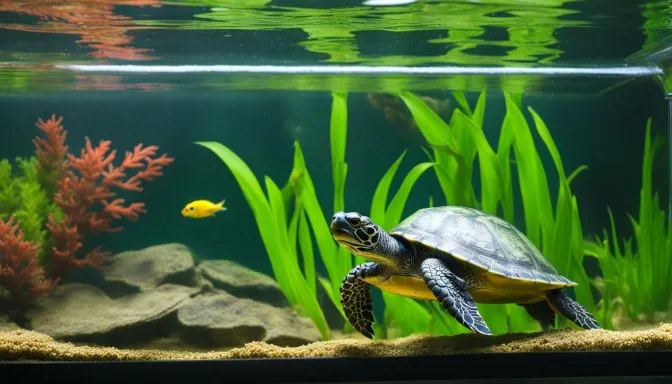
Ammonia, nitrite, and nitrate levels should also be regularly monitored. High levels of these compounds can be detrimental to your turtle’s health.
Ammonia is produced by turtle waste and excess food, while nitrite and nitrate are byproducts of the nitrogen cycle.
Regular water testing will help you identify any imbalances and take appropriate action, such as partial water changes.
| Parameter | Ideal Range |
|---|---|
| pH | 6.8-7.8 |
| Chlorine | 0 ppm |
| Ammonia | 0 ppm |
| Nitrite | 0 ppm |
| Nitrate | 10-20 ppm |
Regular water testing and maintenance are essential for the well-being of your turtle. By ensuring proper water quality, you create a healthy environment that promotes their growth and longevity.
Remember to follow the guidelines provided for your specific turtle species to provide the best care possible.
Creating a Healthy Habitat for Your Turtle
Besides the water itself, there are other important factors to consider when creating a healthy habitat for your turtle, including filtration, temperature control, proper lighting, and the presence of hiding spots.
These elements play a crucial role in providing a comfortable and thriving environment for your pet.
First and foremost, filtration is essential in maintaining clean and safe water for your turtle. A good filtration system helps remove impurities, such as waste and debris, and keeps the water quality optimal.
Depending on the size of your tank, choose a filter that can effectively handle the volume of water and provide adequate mechanical and biological filtration.
Temperature control is another key aspect to consider. Turtles are ectothermic, meaning they rely on their environment to regulate their body temperature.
It is important to provide a temperature gradient within the tank, with a basking area that reaches the proper temperature for your specific turtle species.
A combination of a heat lamp and a heating pad can help achieve the desired temperature range.
Proper lighting is crucial for your turtle’s overall health and well-being. Turtles require both UVA and UVB light to aid in vitamin D synthesis and calcium absorption. Invest in a high-quality UVB bulb specifically designed for reptiles and provide a light cycle that mimics their natural day and night patterns.
| Important factors for a healthy turtle habitat: |
|---|
| Filtration system |
| Temperature control |
| Proper lighting |
| Hiding spots |
Remember to provide hiding spots within the tank. These can include rocks, caves, or artificial plants. Hiding spots create a sense of security for your turtle and offer places for them to rest and explore. Ensure that the hiding spots do not obstruct the turtle’s mobility or access to basking areas.
In addition to these factors, it is important to monitor and maintain the cleanliness of the tank regularly. Perform partial water changes every two weeks, replacing approximately 25% of the water volume, to keep the water fresh and free from harmful contaminants.
Regularly test the water parameters, including pH, chlorine, ammonia, nitrite, and nitrate levels, to ensure they are within the appropriate range for your turtle’s health.
By considering these factors and providing a suitable habitat for your turtle, you can create an environment that promotes their overall health and happiness.
Remember to research the specific requirements of your turtle species to ensure you are meeting their individual needs.
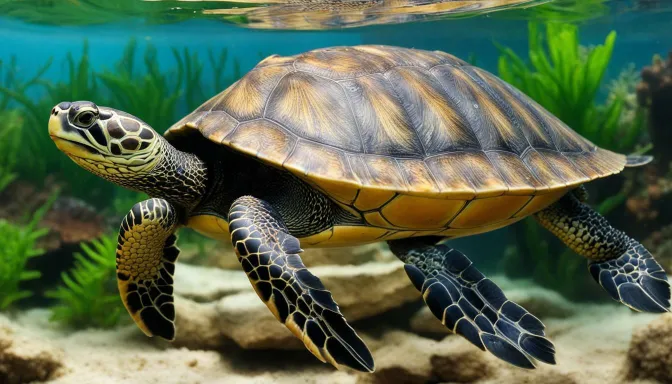
Providing the appropriate amount of water in your turtle tank is crucial for the well-being and happiness of your pet, as it directly affects their natural behavior and health.
The amount of water to put in a turtle tank depends on the species of turtle.
If you have aquatic turtles, it is recommended to fill at least 60% of the tank with water. This allows them to swim and dive, mimicking their natural habitat.
On the other hand, tortoises require very little water in their tank, as they are adapted to live in arid environments.
It’s important to provide them with a suitable terrestrial environment where they can rest and move around comfortably.
Final Thoughts
For semi-aquatic turtles, it’s best to create a habitat that includes both water and land. This means filling at least 25% of the tank with water, allowing them to swim and bask as needed.
Maintaining a proper water level is essential for their overall well-being.
Regardless of the water quantity, it’s crucial to regularly change around 25% of the water every two weeks.
This helps maintain the water quality and prevent the buildup of harmful substances. Additionally, it’s important to have a tank that is spacious enough for your turtle’s size.
As a general guideline, aim for at least 10 to 15 gallons of water for every one inch of your turtle’s length.
Lastly, clean water is essential for the health of your turtle. Tap water should be tested or treated to ensure it meets the proper pH, chlorine, ammonia, nitrite, and nitrate levels.
This ensures a safe and healthy environment for your beloved pet.
FAQ
Q: How much water should I put in a turtle tank?
A: The amount of water to put in a turtle tank depends on the species of turtle. Aquatic turtles should have at least 60% of the tank filled with water, while tortoises should have very little water in their tank. Semi-aquatic turtles should have a mixture of water and terrestrial environments, with at least 25% of the tank filled with water.
Q: How often should I change the water in a turtle tank?
A: Regardless of the amount of water in the tank, a water change of around 25% should be done every two weeks. Regular water changes are important for maintaining a clean and healthy habitat for your turtle.
Q: How big should the tank be for my turtle?
A: It is important to have a tank that is big enough for the turtle’s size. A general guideline is to have at least 10 to 15 gallons of water for every one inch of turtle. This ensures that your turtle has enough space to swim and bask comfortably.
Q: Can I use tap water in my turtle tank?
A: Tap water can be used in a turtle tank, but it is important to test or treat it to ensure that it meets the proper pH, chlorine, ammonia, nitrite, and nitrate levels. Clean water is essential for the health of your turtle.


